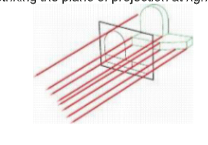
ORTHOGRAPHIC PROJECTION
Orthographic projection is the method of representing the exact shape of an object by
carrying perpendicular rays from two or more sides of the object to picture planes
generally at right angles to each other, collectively the views on these planes must
describe the object completely. We assume in this case that parallel rays of sight
emerge from the object striking the plane of projection at right

Fig. 3.4 Orthographic Projection.
angles. The word “ortho” means 90°.
As the observer of section 3.5 moves backwards from the object, the difference of
angle between the rays from various points of the object starts decreasing. Consider the
observer to be at a theoretically infinite distance from the object, in other words, assume
that the distance in between the observer and the object becomes much greater than
the dimensions of the object. The rays of sight will become nearly parallel to each
other and perpendicular to the picture plane. The image so formed on the picture plane
or in the eye of the observer will be an orthographic view. For ordinary drawing work,
orthographic views are imagined only and we are usually unable to see such views
actually. It is important to note that although these views are generally imagined,
orthographic views are not purely imaginary. For example, the view taken directly
underneath from an aeroplane, when it is at its full altitude, is very close to an
orthographic view. Also a model, having maximum dimension equal to 4in placed at a
distance of about 6ft and viewed with a single eye yields a view very near to the
orthographic view.
Important points about orthographic projection are as follows:
1. The rays of sight are always parallel to each other and perpendicular to the plane of
projection.
2 . Actual dimensions of the object are represented on the views and we may scale
out the dimensions from these views.
3 . Orthographic views are always two dimensional, one of the three general
dimensions is missing in a particular view. Hence the shape is not represented by a
single view and generally three views from different directions are required.
4. Using certain fixed conventions, we may also communicate the inner shape of the
object on these views.
5. As a general rule, no shading or colouring is done in orthographic views except in
some special cases.






